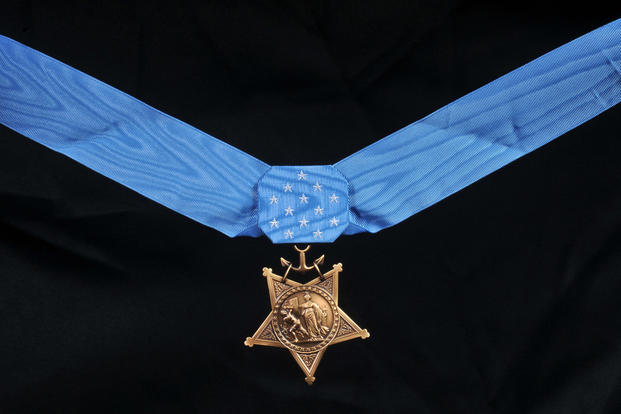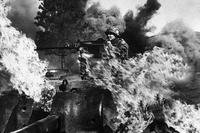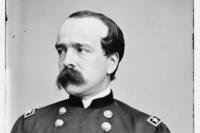The Medal of Honor is the highest military award. It is given to military members, often posthumously, for "conspicuous gallantry and intrepidity at the risk of life above and beyond the call of duty." The Medal of Honor is awarded by the U.S. president, typically during a formal ceremony at the White House.
The Medal of Honor has been awarded more than 3,500 times to members of the Army, Air Force, Navy, Coast Guard and Marine Corps. While the medal is earned in recognition of specific actions, it's never considered "won."
Although more rarely awarded today, the award has been used more liberally in the past. For example, more than 40% of Medal of Honor awards occurred during the Civil War or in the several years after the award was originally created in 1861.
A small number of service members have received the Medal of Honor twice, all for actions during or before World War I. Theodore Roosevelt is the only president to have been awarded the Medal of Honor. He was given it posthumously in 2001 in recognition of his actions during the Spanish-American War 100 years prior.
Dr. Mary Walker, a civilian who served with the Army during the Civil War, is the only female Medal of Honor recipient.
What Does the Medal of Honor Look Like?
There are three variations of the Medal of Honor: those of the Department of the Army, Department of the Navy and Department of the Air Force variant.
While all three feature a five-point star hung from a blue neck ribbon, each features a different centerpiece. The Army and Air Force variants contain the word "valor" between the star and ribbon, and the Navy variant features an anchor between the ribbon and the star medal. Members of the Coast Guard and Marine Corps are eligible for the Navy's variant.
History of the Medal of Honor
The original Medal of Honor was established for the Navy through a law passed by Congress and signed by President Abraham Lincoln in 1861. A second law passed in 1862 established the Medal of Honor for the Army, and a law passed in 1863 made it a permanent military award. The Army and Navy's variations have been redesigned several times, with the current versions created during World War II.
Who Can Receive a Medal of Honor?
While the requirements for the Medal of Honor have changed over time, it has been primarily reserved for military members only. The only exception, Dr. Mary Walker, was a civilian who worked for the U.S. Army during the Civil War at a time when women were not permitted to join the military.
As of 1963, the Air Force, Department of the Navy and Army have the same criteria for how an individual qualifies for consideration.
The law states that the medal is meant to recognize someone who "distinguished himself conspicuously by gallantry and intrepidity at the risk of his life above and beyond the call of duty.” It also says that the act of valor must occur in one of the following circumstances:
- While engaged in action against an enemy of the United States.
- While engaged in military operations involving conflict with an opposing foreign force.
- While serving with friendly foreign forces engaged in an armed conflict against an opposing armed force in which the United States is not a belligerent party.
Who Has Received the Medal of Honor?
More than 3,500 service members have been awarded the Medal of Honor, including nine medals awarded to "unknown" people, honoring service members who died but who cannot be identified. Five such awards were given to unknown soldiers from foreign nations in World War I, and a medal was awarded to one unknown American service member in World War I, World War II, Korea and Vietnam.
This is a rundown of awards by conflict or situation, according to the Congressional Medal of Honor Society:
- Civil War: 1,525
- Indian Wars: 426
- Korean Expedition: 15
- Spanish-American War: 110
- Samoa Campaign: 4
- Philippine Insurrection: 82
- Action Against Outlaws (Philippines): 6
- Boxer Rebellion: 59
- Mexican Campaign: 56
- Haitian Campaign (1915): 6
- Dominican Campaign: 3
- World War I: 126
- Haitian Campaign (1919-1920): 2
- Second Nicaraguan Campaign: 2
- World War II: 472
- Korean War: 151
- Vietnam War: 270
- Somalia: 2
- War on Terrorism (Afghanistan): 20
- War on Terrorism (Iraq): 8
- Non-combat: 193
- Unknown: 9
Medal of Honor Benefits
Medal of Honor recipients are given the following special privileges and benefits:
- Special Medal of Honor pension of over $1,600 per month on top of any military pensions or other benefits for which they may be eligible. Most surviving spouses are also eligible for this pension The MoH pension is subject to cost-of-living increases and is tax free.
- Special entitlements to Space-Available air transportation.
- Enlisted recipients are entitled to a supplemental uniform allowance.
- Commissary and exchange privileges (includes eligible dependents).
- Admission to the United States military academies for qualified children of recipients, without nomination and quota requirements.
- 10% increase in retired pay.
- Medal of Honor flag.
- Permission to wear their uniform anytime, as long as the standard restrictions are observed.
- Medal of Honor automobile license plates in many states.
- Interment at Arlington National Cemetery, if not otherwise eligible.
National Medal of Honor Day
National Medal of Honor Day is recognized on March 25 to acknowledge and honor all recipients of the Medal of Honor. On March 25, 1863, more than 20 men were presented the medal for actions during the Civil War. Congress established National Medal of Honor Day in 1990, choosing that date to honor those men. The day is meant to "foster public appreciation and recognition of Medal of Honor recipients," according to the law. Members of the Congressional Medal of Honor Society mark the day by laying a wreath at the Tomb of the Unknown Soldier in Arlington National Cemetery.
Stay on Top of Your Veteran Benefits
Military benefits are always changing. Keep up with everything from pay to health care by subscribing to Military.com, and get access to up-to-date pay charts and more with all latest benefits delivered straight to your inbox.























